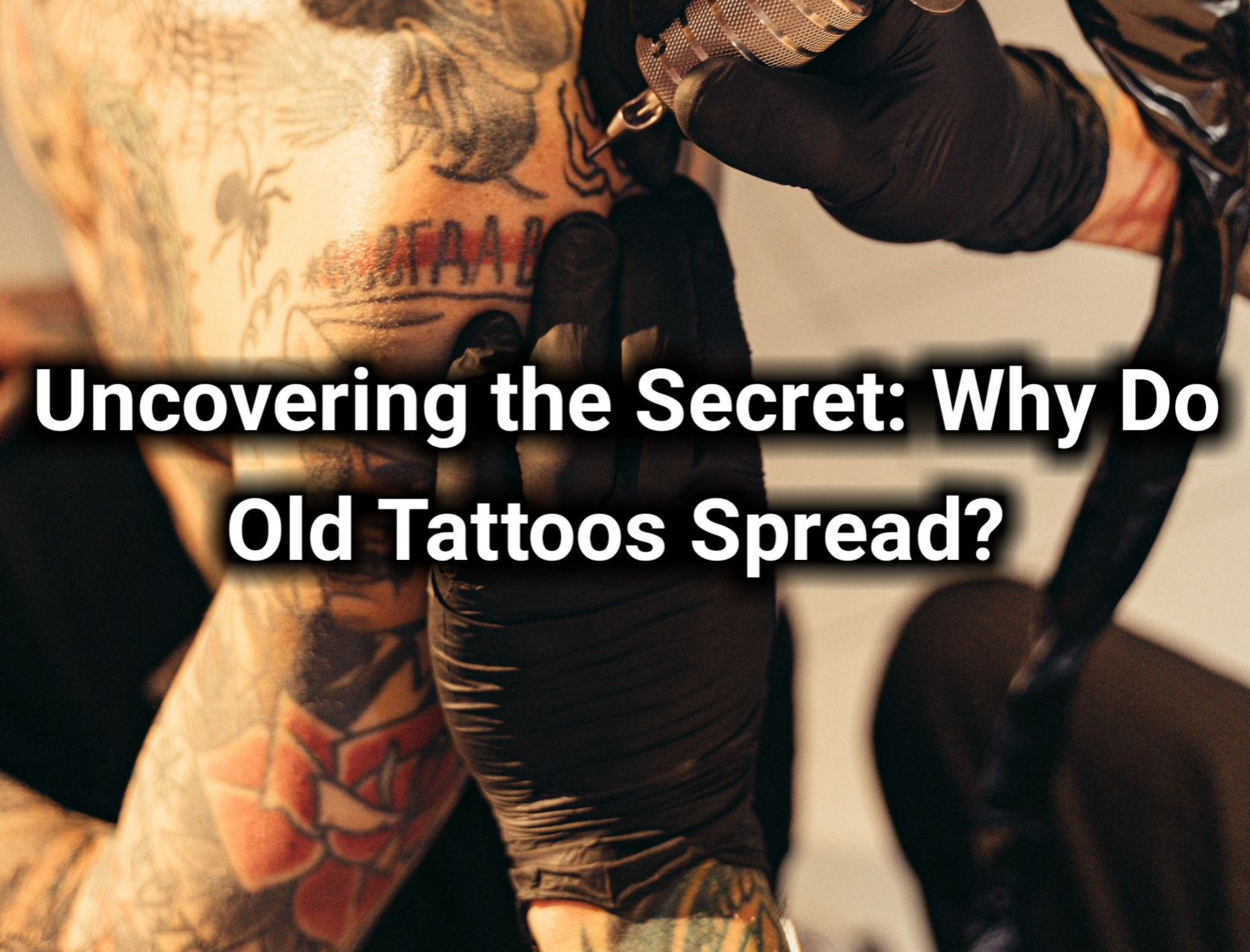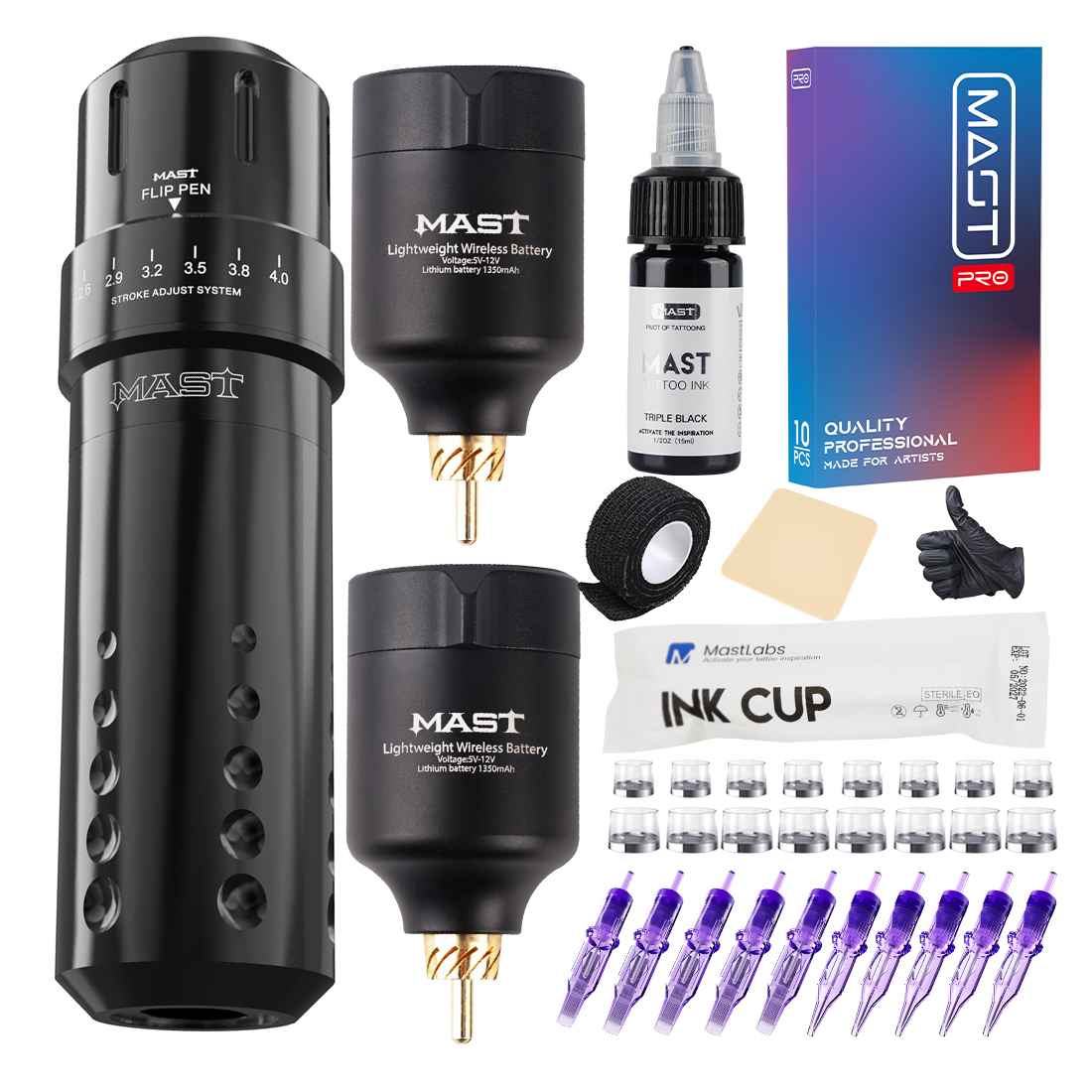Have you ever wondered why that once finely detailed and carefully placed tattoo on your arm seems to have gradually expanded and lost its original sharpness over time?
It’s a common experience shared by many tattoo enthusiasts and often leaves them pondering the intriguing phenomenon known as tattoo spread.
Understanding why old tattoos spread is not only a fascinating journey into the intricacies of the human body, but it also holds significant importance for both seasoned tattoo enthusiasts and those considering getting inked.
In this blog post, we will delve into the mysterious world of tattoo migration, exploring the reasons behind this phenomenon and shedding light on the factors that contribute to the evolution of our beloved body art.
Get ready to uncover the secrets behind the subtle transformations that occur beneath our skin, and embark on a captivating exploration of the question “Why do old tattoos spread?”
Understanding the Anatomy of Tattoos
Tattoos are a remarkable form of self-expression, etching vivid stories and symbols onto our bodies that hold deep personal meaning.
They have the power to captivate and inspire, but have you ever stopped to ponder the intricate relationship between your tattoo and the canvas it adorns—the human skin?
Understanding the anatomy of tattoos takes us on a fascinating journey into the layers of our skin, the artful techniques of tattooing, and the enduring nature of these indelible marks.
Layers of the Skin and Their Role: A Living Canvas
Our skin is an extraordinary organ, boasting an intricate architecture that serves as the foundation for tattoos.
Comprising three primary layers—the epidermis, the dermis, and the subcutaneous tissue—each plays a vital role in the art of tattooing.
The epidermis, the outermost layer, acts as the protective shield, constantly renewing itself and ensuring our skin remains resilient.
However, tattoo pigment placed solely within this layer would quickly fade, as it sheds and regenerates itself.
This is why tattoo artists skillfully penetrate deeper into the dermis—the middle layer—where ink can be deposited in a more stable environment.
How Tattoos Are Inserted into the Skin: An Artful Symphony
Tattooing is an intricate dance between the artist’s hand and the recipient’s skin. Using a tattoo machine, a cluster of needles rapidly punctures the skin, injecting ink droplets into the dermis.
These tiny punctures trigger a response from our body’s defense mechanisms, setting in motion a complex healing process that eventually embeds the ink within the tissue.
The skill of the tattoo artist lies not only in their artistic vision but also in their understanding of the skin’s topography and the optimal depth for the tattoo to be placed.
Precise needle control and an artistic touch create the harmonious synergy between the tattoo and the canvas, resulting in a masterpiece that resonates with its wearer.
Also Read: Is it possible for a tattoo to move?
The Permanent Nature of Tattoos: Stories Written in Ink
Tattoos are known for their longevity, proudly carrying stories, memories, and identities throughout a lifetime.
Once the ink settles within the dermis, it becomes a part of us, anchored amidst the network of collagen fibers that make up this layer.
As the skin regenerates and sheds cells, the tattoo remains relatively unchanged due to its depth within the dermis.
However, over time, the aging process and environmental factors can contribute to subtle changes in the tattoo’s appearance.
Collagen fibers shift and disperse, leading to the phenomenon commonly referred to as tattoo spread.
The precise intricacies of why this occurs are still being unraveled by scientific inquiry, adding an air of mystique to our cherished body art..
Factors Contributing to Tattoo Spread
A tattoo is not just an art form; it is an expression of our individuality, etched onto our skin to create a lasting statement.
However, as time passes, many tattoo enthusiasts notice their once pristine ink gradually spreading and losing its initial sharpness.
The question arises: what causes this intriguing phenomenon of tattoo spread?
1. Age and Condition of the Tattoo
Just like a fine piece of artwork, tattoos can age and deteriorate over time. The quality of the original tattoo and how well it was cared for can significantly impact its longevity.
Older tattoos tend to spread more due to the natural breakdown of pigments and the stretching of the skin.
2. Skin Elasticity and Changes Over Time
Our skin is a dynamic organ that undergoes changes as we age. The loss of collagen and elastin fibers, which provide strength and elasticity, can lead to a decrease in the skin’s ability to maintain the original shape of the tattoo.
As the skin loses its firmness, it becomes more susceptible to sagging, causing the tattoo to spread and blur.
3. Sun Exposure and UV Damage
The sun, while a source of warmth and vitality, can be a formidable adversary to our tattoos.
Overexposure to ultraviolet (UV) rays can accelerate the breakdown of the pigments beneath the skin, causing them to spread and fade.
To preserve the integrity of your tattoo, it is crucial to shield it from excessive sun exposure and regularly apply a high-quality sunscreen.
4. Weight Fluctuations and Body Changes
Our bodies are dynamic and subject to fluctuations in weight, muscle mass, and overall shape.
Significant weight gain or loss can alter the distribution of fat and muscle beneath the skin, causing the tattoo to stretch and distort.
Body changes such as pregnancy or muscle growth can also impact the appearance and position of a tattoo.
5. Poor Tattooing Techniques or Equipment
The skill and expertise of the tattoo artist play a vital role in the longevity of your ink. Inferior tattooing techniques, the use of low-quality pigments, or outdated equipment can contribute to tattoo spread.
A skilled and experienced artist, using high-quality materials, will ensure that the tattoo is applied with precision, reducing the risk of future spreading.
Also Read: What happens to tattoos when you are older?
Mechanisms of Tattoo Spread
The world of tattoos is a vibrant tapestry of self-expression, where inked art becomes a part of our identity.
However, as time passes, many tattoo enthusiasts notice a subtle transformation in their once pristine designs – the phenomenon known as tattoo spread.
To truly appreciate this captivating journey, we must unravel the mechanisms that lie beneath the surface of our skin.
1. Migration of Pigment Particles: A Dance of Colors
Imagine a microscopic dance of colors unfolding within the intricate layers of your skin.
When a tattoo artist skillfully injects ink into the dermis, it settles into a web of tiny cavities.
Over time, however, the movement of pigment particles becomes inevitable.
Gravity, lymphatic fluid, and natural bodily processes can cause these particles to gradually drift away from their original positions.
The result?
Your tattoo may appear slightly blurred or stretched, as if it’s expanding its reach across your skin.
2. Diffusion within the Skin Layers: An Artful Blending
Within the depths of your dermis lies a complex network of cells, collagen fibers, and interstitial fluid.
As time passes, the ink particles in your tattoo may diffuse through this intricate web, creating an artful blend of colors beyond the initial boundaries.
This diffusion process can contribute to the spread of your tattoo, blurring the once crisp lines and blending shades together in unexpected ways.
It’s like a painter’s brushstroke, gently spreading its pigments across the canvas, transforming the original artwork into a unique masterpiece.
3. Cell Turnover and Renewal Process: The Ever-Changing Canvas
Our bodies are in a constant state of renewal, as old cells give way to new ones.
In the case of tattoos, this cell turnover plays a significant role in their evolution.
As skin cells regenerate, the layers above the tattoo undergo a continuous cycle of shedding and replenishment.
This ongoing process can subtly alter the appearance of your tattoo, causing it to spread and morph over time.
The canvas of your skin becomes a living tapestry, forever changing and adapting, leaving its mark on the art it carries.
Also Read: Do tattoos move with age?
Common Examples and Observations
As time passes, tattoos, like all things in life, undergo transformations.
What was once a vibrant and intricately detailed piece of body art may gradually lose its initial sharpness, leaving its owner bewildered.
Let’s take a closer look at some common examples and observations that shed light on the captivating phenomenon of tattoo spread.
1. Blurring of Fine Lines and Details
Imagine a meticulously crafted tattoo with lines so fine and detailed that they resembled a work of art.
Over the years, however, those once pristine lines may start to blur and lose their clarity.
This blurring effect is often caused by the natural aging process of the skin. As we grow older, our skin loses elasticity and becomes less supple.
This gradual loss of elasticity can lead to the stretching and sagging of the skin, which in turn causes the fine lines of a tattoo to expand and lose their defined edges.
Additionally, exposure to sunlight, improper aftercare, and certain lifestyle factors such as weight gain or loss can also contribute to the blurring effect.
2. Spreading of Colors and Pigments
Another intriguing aspect of tattoo spread lies in the spreading of colors and pigments.
Vibrant hues that once adorned the skin with brilliance may start to migrate beyond their original boundaries.
This migration is often attributed to the movement of the body’s lymphatic system.
The lymphatic system plays a vital role in waste removal and the circulation of immune cells throughout the body.
However, its natural flow can cause pigments from the tattoo to disperse gradually.
This phenomenon is more noticeable in larger tattoos or areas with a higher concentration of pigments.
While color spreading is a common occurrence, it is important to note that not all tattoos will experience this effect to the same degree.
3. Fading and Distortion of the Tattoo Design
One of the most noticeable transformations that occur in old tattoos is the fading and distortion of the original design.
The vibrant colors that once caught the eye may gradually lose their intensity, resulting in a more muted appearance.
Exposure to sunlight, which contains ultraviolet (UV) radiation, is a major contributing factor to tattoo fading.
UV radiation can break down the pigments within the skin, leading to color loss and a duller overall appearance.
Moreover, the continuous turnover of skin cells through the natural process of shedding and regeneration can also contribute to the gradual distortion of the tattoo design over time.
As new skin cells replace the old ones, the original pattern may become less defined and lose its initial precision.
Preventive Measures and Aftercare
As you embark on this exciting journey of tattoo ownership, it’s crucial to prioritize preventive measures and diligent aftercare to ensure your ink remains vibrant and pristine for years to come.
Let’s explore a range of proactive steps you can take to safeguard your tattoo’s longevity, from selecting a skilled artist to embracing a nurturing aftercare routine.
1. Choosing an Experienced Tattoo Artist: The Foundation of Longevity
When it comes to tattoos, the first step towards preventing spread and maintaining clarity begins with selecting an experienced and reputable tattoo artist.
A skilled artist understands the nuances of ink placement and employs techniques that minimize the risk of migration.
They possess a keen eye for detail, ensuring that your tattoo’s lines remain crisp and colors stay true.
Take the time to research and visit different artists, review portfolios, and seek recommendations from trusted sources.
By investing in the expertise of a seasoned professional, you’re laying a strong foundation for a tattoo that defies the passage of time.
2. Proper Tattoo Aftercare Techniques: Nurturing the Healing Process
Once the tattooing process is complete, your artist will guide you on proper aftercare techniques.
Pay close attention to their instructions as they provide valuable insights into keeping your tattoo healthy and vibrant.
Embrace a routine that involves gentle cleansing with mild, fragrance-free soap, followed by the application of a recommended tattoo-friendly moisturizer.
Keep your tattoo clean and moisturized during the initial healing phase, avoiding excessive exposure to water, sunlight, and abrasive materials.
By providing the necessary care, you’ll nurture your tattoo’s healing process, minimizing the risk of spread and maximizing its visual impact.
3. Sun Protection and Regular Moisturization: Shielding Your Artwork
Our skin is constantly exposed to the powerful rays of the sun, which can have adverse effects on tattoos.
Sunburns, fading, and spread are common concerns that can be prevented through diligent sun protection.
Shield your tattoo from direct sunlight by applying a broad-spectrum sunscreen with a high SPF, even on cloudy days.
Opt for clothing that covers your ink when spending extended periods outdoors.
Additionally, regular moisturization plays a vital role in preserving your tattoo’s integrity.
Keep your skin hydrated with tattoo-specific lotions or fragrance-free moisturizers, which help retain vibrant colors and prevent the appearance of faded or spread tattoos.
4. Maintaining a Stable Weight and Healthy Lifestyle: Body Art’s Best Friend
Weight fluctuations can contribute to the spread of tattoos, particularly in areas prone to stretching.
Maintaining a stable weight can help preserve the integrity of your ink, preventing distortion and ensuring its original design remains intact.
Adopting a healthy lifestyle that includes regular exercise, a balanced diet, and ample hydration benefits not only your overall well-being but also supports the longevity of your tattoo.
Nourishing your body from within promotes healthy skin, contributing to the vibrancy and sharpness of your cherished artwork.
Also Read: Do tattoos change with age?
Tattoo Touch-ups and Cover-ups
As time passes, even the most vibrant tattoos may begin to lose their original luster.
Thankfully, there are a plethora of options to breathe new life into your inked masterpieces.
1. Options for refreshing and enhancing old tattoos
Here are the options available to enhancing old tattoos;
Color Enhancement: Over time, tattoos can experience color fading due to factors such as sun exposure, aging, or improper aftercare.
Fortunately, skillful tattoo artists can revitalize your tattoo’s vibrancy by strategically adding or intensifying colors, bringing back its original brilliance.
Line Refinement: As our skin ages, natural changes occur, causing fine lines and wrinkles. These changes can inadvertently affect the sharpness and clarity of tattoo lines.
By employing techniques such as line redefinition and touch-up work, talented artists can restore the crispness and precision of your tattoo’s linework, breathing new life into the design.
Background and Detail Addition: For tattoos that lack depth or visual interest, introducing new elements such as background shading, additional details, or textures can transform a once simple tattoo into a stunning, multidimensional work of art.
2. Choosing the right tattoo artist for touch-ups
When considering a touch-up, it is crucial to entrust your beloved tattoo to an experienced and reputable artist.
Here are a few factors to consider in selecting the perfect artist:
Expertise in Touch-up Work: Look for artists who specialize in tattoo touch-ups and have a portfolio showcasing successful transformations of faded or aging tattoos.
Their expertise in color restoration and line refinement will ensure the best possible outcome.
Communication and Collaboration: Seek out artists who actively listen to your desires and collaborate closely with you to understand your vision.
A great touch-up artist will incorporate your ideas while offering their professional insight, resulting in a harmonious fusion of creativity.
Reputable Studios: Research well-established tattoo studios with a solid reputation for excellence, cleanliness, and a commitment to customer satisfaction.
Reading reviews, checking online portfolios, and seeking recommendations from friends or fellow tattoo enthusiasts can help you find the right studio for your touch-up needs.
3. Cover-up techniques and considerations
Sometimes, a tattoo may no longer align with our evolving tastes or hold the same significance it once did.
In such cases, a cover-up tattoo presents an exciting opportunity for reinvention. Consider the following when embarking on a cover-up:
Design Expertise: Seek an artist with a strong background in cover-up work.
Their ability to reimagine and skillfully incorporate new elements into your existing tattoo will be crucial for achieving a seamless and visually appealing result.
Color and Placement Considerations: Depending on the existing tattoo’s colors and size, the artist may recommend specific design choices and color palettes to effectively conceal the original ink.
Open communication with the artist is essential to ensure your cover-up aligns with your aesthetic preferences.
Patience and Trust: Cover-up tattoos are intricate projects that require time, planning, and the artist’s expertise.
Trust the process and be patient, knowing that the final result will be a harmonious fusion of your original tattoo and the new design.
Conclusion
In conclusion, understanding the answers to the question, “Why do old tattoos spread?” unveils a captivating journey into the complexities of our skin and the artistry of tattooing.
We’ve discovered that factors like natural skin changes, sun exposure, and improper aftercare can contribute to the gradual expansion and fading of our beloved ink.
However, it’s crucial to emphasize the significance of proper care and maintenance to minimize tattoo spread and preserve their original beauty.
Yet, there’s a certain charm in the unique character that aged tattoos acquire over time.
These faded lines and softened colors tell stories of experiences, growth, and memories—a testament to the enduring nature of body art.
So, let’s embrace the evolution of our tattoos and appreciate the timeless allure they possess, despite their subtle spread.






